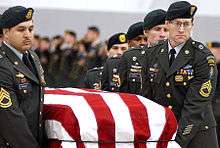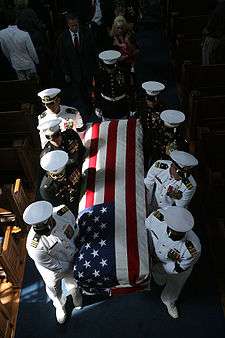Military funeral

A military funeral is a memorial or burial rite given by a country's military for a soldier, sailor, marine or airman who died in battle, a veteran, or other prominent military figures or heads of state. A military funeral may feature guards of honor, the firing of volley shots as a salute, drumming and other military elements, with a flag draping over the coffin.
Canada
Canadian military funerals involve many rituals seen in other parts of the world. The Royal Canadian Horse Artillery use a 25-pounder gun and limber as the funeral vehicle. Muffled drums accompany the graveside processional. The deceased's headdress, insignia and medals are borne on a velvet cushion into the funeral service. Volleys are fired over the grave when the body is interred. Countries in the Commonwealth duplicate the British military drill and ceremony. The Canadian funeral described above typifies the funerary service. The bugle tune Last Post is played as the body is interred.
Chile
In Chilean military funerals, due to its Prussian military tradition, the German song "Ich hatt' einen Kameraden" is sung in its Spanish version ("Yo tenía un camarada"). The casket may or may not be horse-drawn on a caisson. A bugler sounds the final honors during interment.
Germany
In Germany, Ludwig Uhland's song "Ich hatt' einen Kameraden" is an integral part of a military funeral. It is played when the coffin is lowered into the grave, military personnel will perform a salute.
Indonesia
In Indonesia, military funerals are generally given only military members or former guerrillas, Konfrontasi and Trikora Operation Soldiers, especially those holding the Bintang Gerilya (Star of the Guerrilla). Exceptional politicians and Ministers have the option for such a funeral, but most opt for a more intimate religious one. Music is not performed as it is not part of Indonesian military tradition, save only during the final honors. A 21-gun volley salute is the norm by seven soldiers- occasionally a mixture of armed forces personnel dependent on their career,[1] Honour drill team is platoon-size formation and the larger the platoon or half company, the more illustrious the departed. A good example of an Indonesian military burial is that of the late president Suharto- (although obvious major differences exist). Prayers are led by representatives of the person's religious faith.
Similar traditions also exist in the Indonesian National Police.
Italy

In Italy the members of the Armed Forces who died in the line of duty are granted a state funeral by decree of the Prime Minister.[2] So the funeral follows the protocol of a state funeral, and in particular the six officers in high uniform who carry the coffin are members of the same Armed Force of the departed.
Poland
In Poland, the last fragment of Władysław Tarnowski's song Śpij, kolego ("Sleep, friend"),[3][4][5] a portion of the larger composition Jak to na wojence ładnie (the title has no precise English translation, but it is roughly "how nice it is in war", with a diminutive form conveying a sense of ironic solidarity)[6] is an integral part of a military funeral, played by a trumpeter. It is also played during state ceremonies. Also part of it is a three volley salute (salwa honorowa) with the firing party consisting of an armed platoon or company.
Spain
In Spain, the formed troops sing "La muerte no es el final": Death is not the End during funeral ceremonies and in all military ceremonies, when the fallen are being honored. The Spanish Legion has an exception: the regimental hymn Novio de la Muerte (Bridegroom of Death) is played in full instead during occasions that the Legion attends.
United Kingdom
The British Army carries reversed arms at military funerals. The Last Post and Rouse or Reveille are sounded at the right moment during the rite.
United States of America
In the United States, the United States Army Military District of Washington (MDW) is responsible for providing military funerals. "Honoring Those Who Served" is the title of the program for instituting a dignified military funeral with full honors to the nation's veterans.
As of January 1, 2000, Section 578 of Public Law 106-65 of the National Defense Authorization Act mandates that the United States Armed Forces shall provide the rendering of honors in a military funeral for any eligible veteran if requested by his or her family. As mandated by federal law, an honor guard detail for the burial of an eligible veteran shall consist of no fewer than two members of the Armed Forces. One member of the detail shall be a representative of the parent armed service of the deceased veteran. The honor guard detail will, at a minimum, perform a ceremony that includes the folding and presenting of the flag of the United States to the next of kin and the playing of Taps which will be played by a lone bugler, if available, or by audio recording.[7] Today, there are so few buglers available that the United States Armed Forces often cannot provide one.[8] However, federal law allows Reserve and National Guard units to assist with funeral honors duty when necessary. On the day of the burial or interment, the U.S. Flag is lowered to half-mast.
Other
- After the 2006 Lebanon war, Hezbollah draped coffins containing their dead in Hezbollah flags with flowers on top. They were given a funeral according to Shiite Muslim traditions, then buried in their hometowns.
- Irish Republican Army members have been accorded military funerals.
- On occasion, deceased soldiers have been accorded military funerals by their enemies (for example, see Manfred von Richthofen).
- In 2015, Lee Kuan Yew, the former prime minister of Singapore, was given a state funeral with full military honours.
Gallery
-

The military funeral of U.S. Navy Rear Admiral Henry H. Bell held in Hiogo, Japan on January 14, 1868.
-

The coffin of Lieutenant Reginald Warneford being carried to his burial plot in Brompton Cemetery by members of the Royal Naval Division on June 21, 1915.
-

The military funeral of Manfred von Richthofen is presided by officers of the No. 3 Squadron RAAF who carry his coffin in Bertangles Cemetery, France on April 22, 1918.
-

Luftwaffe Commander-in-Chief Hermann Göring giving a speech at the military funeral of Night fighter ace Lieutenant Colonel Helmut Lent, winner of the Oak Leaves with Swords and Diamonds to the Knight's Cross of the Iron Cross, October 1944.
-

Members of the Presidential Salute Guns Battery of the 3rd United States Infantry Regiment "The Old Guard" render a gun salute using three-inch anti-tank guns (modified to 75mm caliber) during a military funeral held at Arlington National Cemetery on August 10, 1998.
-

A casket team from the 1st Special Forces Group carry the flag-draped casket of Sergeant 1st Class Nathan R. Chapman on January 8, 2002 at Seattle-Tacoma International Airport.
-

A casket team from the United States Navy fold the flag covering the remains of NASA Astronaut and U.S. Navy Captain Laurel Blair Salton Clark, a crew member of the Space Shuttle Columbia who perished with the rest of her crewmates during the Space Shuttle Columbia disaster in 2003.
-

Military funeral procession for World War II soldier and Victoria Cross recipient Ernest ("Smokey") Smith in Vancouver, Canada on August 13, 2005.
-

The casket of Caspar Weinberger, 15th United States Secretary of Defense, in a ceremonial funeral procession en route to its final resting place in Arlington National Cemetery on April 4, 2006.
-

A casket team from the 3rd United States Infantry Regiment "The Old Guard" transports the remains of Retired Chief Warrant Officer Michael J. Novosel during a ceremonial funeral procession at Arlington National Cemetery where he was laid to rest on April 13, 2006.
-

The Ceremonial Unit assigned to Naval Air Station Lemoore seen rendering honors at a military funeral at San Joaquin Valley National Cemetery in Gustine, California.
-

Escort platoons march in the United States Naval Academy Cemetery as part of the ceremonial funeral procession for former Chairman of the Joint Chiefs of Staff, Admiral William J. Crowe in 2007.
-

A casket team carries Major Douglas A. Zembiec, former commander of E Company, 2nd Battalion, 1st Marine Regiment from the Naval Academy Chapel in Annapolis, Maryland following a funeral service held in his honor.
-

A Canadian honor guard carries the remains of Pte. Sebastien Courcy during a sundown ramp ceremony at Kandahar Air Field, Afghanistan on July 17, 2009.
-

Former Brazilian President Lula during the funeral of MINUSTAH`s Commander.
See also
References
- ↑ (example- a Minister of Transportation may have been a career Army soldier, became a bureaucrat and assisted the national aviation or maritime industry- thus the corresponding Force would send soldiers as gratitude)
- ↑ "Protocol for State Funerals and National Mourning". Official website of the Italian Government - Department of State Ceremonies.
- ↑ "Śpij, kolego (score)" (PDF). Polish Army WEB. Retrieved 14 December 2009. External link in
|publisher=(help) - ↑ "Śpij, kolego (mp3)". Polish Army WEB. Retrieved 14 December 2009. External link in
|publisher=(help) - ↑ Polish text "Jak to na wojence ładnie". Retrieved 3 August 2009.
- ↑ "Jak to na wojence ładnie mp3". Retrieved 3 August 2009.
- ↑ "Veterans Funeral Services". Retrieved 2016-01-01.
- ↑ "What is Military Funeral Honors?". U.S. Department of Defense.
Further reading
- Mossman, B.C.; Stark, M.W. (1991). "77-606843". The Last Salute: Civil and Military Funerals 1921-1969. Washington, D.C.: Department of the Army. CMH Pub 90-1.